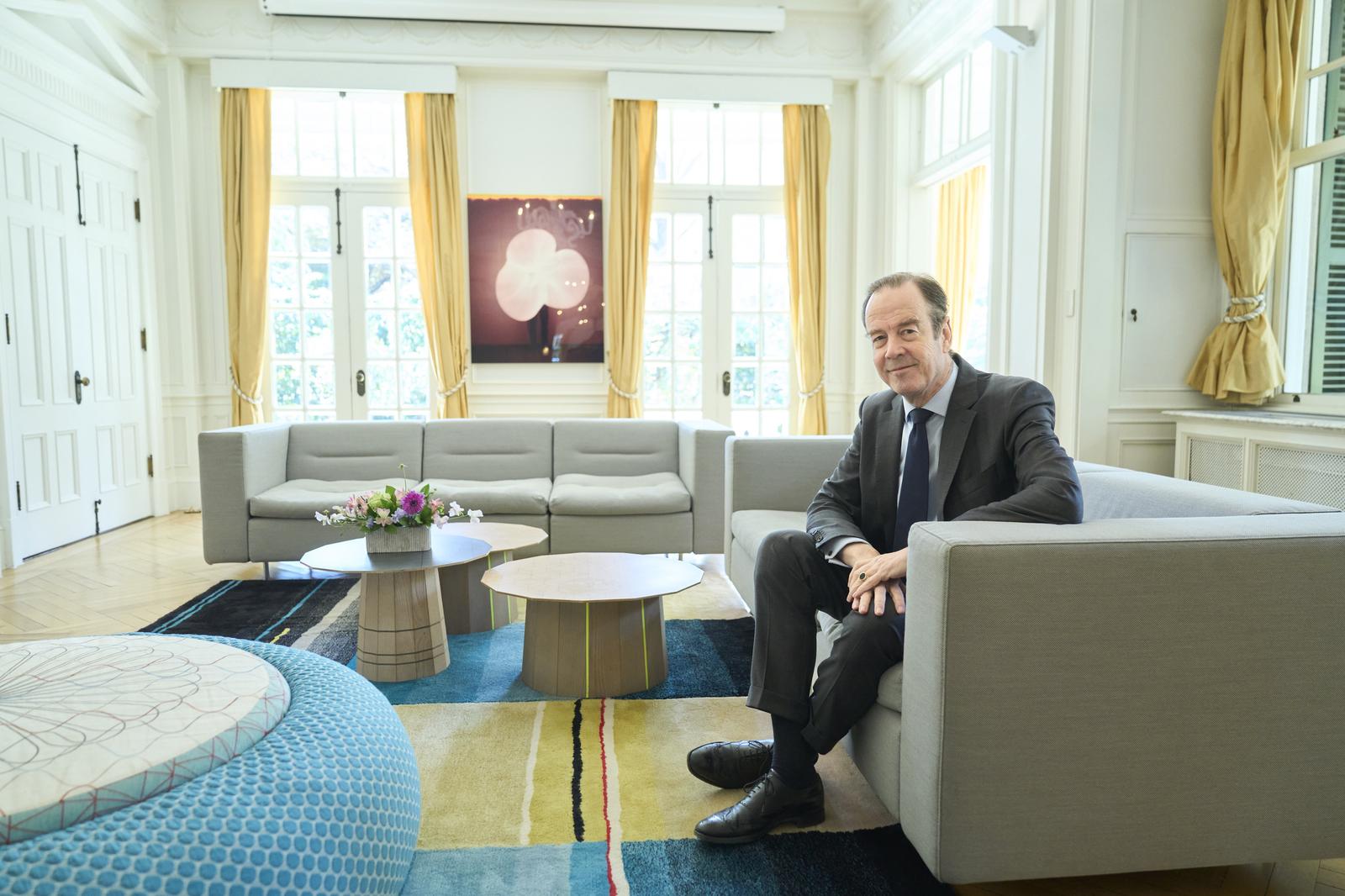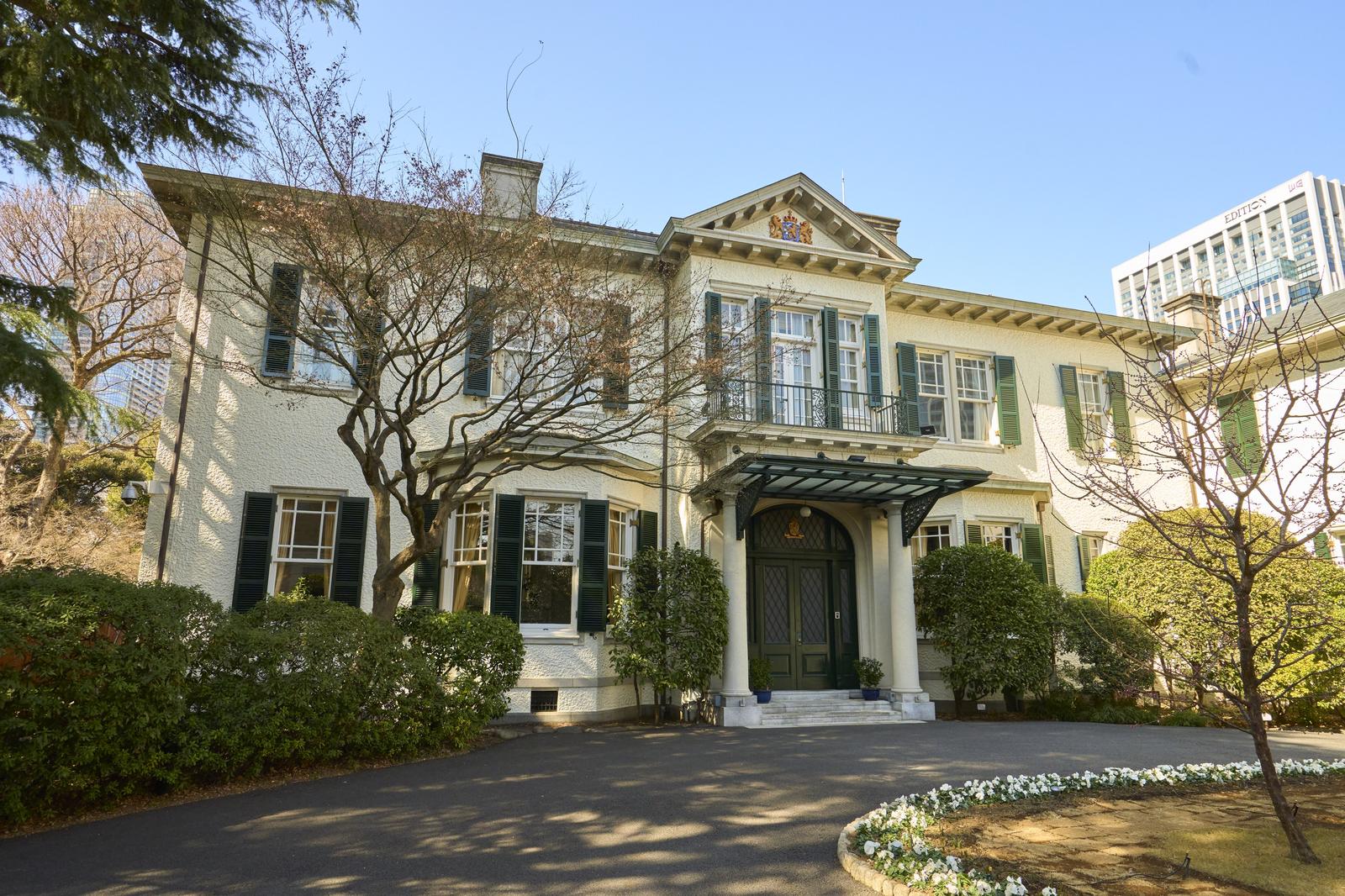It might seem unlikely that a low-lying land of locks and canals in Western Europe and a volcanic archipelago at the eastern edge of Asia would have much to do with one another, but the Netherlands and Japan have maintained diplomatic relations for well over four centuries. Ambassador Gilles Beschoor Plug at the Embassy of the Kingdom of the Netherlands in Japan shares his perspective on the long and fascinating history between the two countries, as well as current relations and plans for cooperation in the future.

Ambassador Gilles Beschoor Plug at the Embassy of the Netherlands in Tokyo.
The Latest in a Long Line of Dutch Ambassadors to Japan
Shortly after arriving in Tokyo last year, Ambassador Plug visited the Imperial Palace to present his letters of credence to His Majesty the Emperor of Japan. The experience sparked his imagination as he considered his many predecessors in the role. Edo, now known as Tokyo, was the political center of Japan during the Edo period (1603-1868), when the country was governed by the Tokugawa shogunate. The earliest encounters between Dutch diplomats and Japanese leaders date back to this time, beginning with Tokugawa Ieyasu, the first shogun of the era.
“I thought of all the Dutch diplomats who presented their letters to Japanese leaders throughout the centuries. Their earliest encounters would have been with the Tokugawa shoguns in Edo Castle, of course, dating back to Tokugawa Ieyasu himself. And so it was humbling to consider that in presenting my letter to the Emperor, I was becoming the latest to join this long line of Dutch ambassadors to Japan.”
The first contact between Japan and the Netherlands occurred in April 1600 when the de Liefde, a Dutch merchant ship, ran aground in Kyushu, the southwesternmost of Japan’s main islands. Piloting the ship was Englishman William Adams, upon whom author James Clavell based his novel Shogun (adapted into an Emmy Award-winning TV series in 2024). One of the Dutch survivors from the de Liefde was Jan Joosten van Lodensteyn, whose name was transliterated into Japanese as Yayōsu. Yaesu, the current district on the east side of Tokyo Station, is derived from Jan Joosten’s Japanese name.
When Japan entered into its two-and-a-half centuries of isolation, now often referred to as sakoku, the Dutch were the sole European nation to be granted special trading privileges by the Tokugawa shogunate. A small community of Dutch merchants was permitted to reside in Japan, albeit only in the city of Nagasaki in Kyushu, on a tiny man-made island known as Dejima.
Ambassador Plug explains that the earliest Dutch diplomatic missions in Japan emerged from Dejima. “The chief trading officers at Dejima were called opperhoofd. Each opperhoofd was required to make the long journey from Nagasaki to Edo to pay tribute to the shogun.” The embassy possesses a copy of the original 1609 edict issued by Tokugawa Ieyasu permitting Dutch ships to visit Japan and Dutch people to safely reside within the country.

The Embassy’s copy of a 1609 edict from shogun Tokugawa Ieyasu, permitting the Dutch to live and trade in Japan.
The vast majority of foreign books that entered Japan during the sakoku period were written in Dutch, leading to a boom in rangaku (Dutch studies) among samurai eager to study the latest Western scientific, technological, and medical developments. This meant that when Japan did finally open its borders in the 1850s, Dutch was virtually the only European language that anyone in the country spoke.
“One of my favorite stories from Dutch-Japanese history is about the Harris Treaty,” smiles Ambassador Plug, referring to the 1858 Treaty of Amity and Commerce signed between Japan and the United States. “I could hardly believe it when I learned that the treaty was written in Japanese, English, and Dutch. Even more astonishing was that the Dutch script was considered the legally binding version!”
The Embassy of the Netherlands, in Tokyo
The Embassy of the Netherlands has occupied its current site in Tokyo since the 1880s when the property was selected and procured by Dutch diplomat Joannes Jacobus van der Pot. At the time, the embassy’s hilltop location in Shiba Kiridoshi (now Shibakoen) offered superb views of Tokyo Bay and Zojoji Temple.
Nowadays, the embassy stands next to Tokyo Tower. The modern embassy building has an attractive curved structure, designed to resemble the shape of Dejima. But it is the ambassadorial residence that is the real treasure here. Reconstructed in 1928 after its destruction in the Great Kanto Earthquake of 1923, the residence is one of the finest examples of architecture from that time still standing in Tokyo.

The ambassadorial residence at the Embassy of the Netherlands in Tokyo, built in 1928.
“It’s very exciting that my wife and I will be here for the residence’s 100-year anniversary,” says Ambassador Plug. “It is a real honor to live in such a beautiful building that has seen so much of Tokyo’s modern history.”
Ambassador Plug has already made considerable efforts to get out and experience Tokyo for himself. “We have no city in the Netherlands that can compare to Tokyo in terms of scale. But the thing about Tokyo is that even though it is such a huge city, there are many quiet neighborhoods that feel almost like being in a village. Tokyo is a clean city, a safe city, a fun city—a city to be proud of.”
Japan and the Netherlands: Toward a Better World for Our Children
With a strong foundation of trust based on their centuries-long relationship, Japan and the Netherlands continue to look forward together when it comes to embracing the opportunities and facing the challenges of the future.
“What we have in common is that we want to take steps now in order to empower our children to make a better world in the future,” says Ambassador Plug. “Both Japan and the Netherlands are known for innovation, pragmatism, and excellent infrastructure. From a Dutch perspective, we are especially advanced in areas such as agriculture, horticulture, water management, green energy, semiconductors, and health, as is Japan. So there are many ways in which we feel that we can work together with our Japanese partners across the public and private sectors.”
The Netherlands has a very active start-up and scale-up scene when it comes to promoting small businesses. Ambassador Plug acknowledges that while the initial push for Dutch companies to get into the Japanese market can be challenging at first, in terms of culture and language, the rewards make it well worthwhile.

Ambassador Plug believes that Japan and the Netherlands can work together for a better future.
With the 2025 Osaka Expo fast approaching, Ambassador Plug and his team have been working hard to ensure that the Netherlands takes an active part in this landmark event for Japan. “From what I understand,” he says, “the previous Expo was seen as opening a new chapter for Japan. I’m confident that this year’s event will do the same.”
Despite his busy schedule, he is eager to make time to get out to see the rest of the country. “I have been to Nagasaki to see Dejima already, of course,” he explains. “As ambassador, I have always made it a priority to really get out there and learn as much as I can about every country that I’ve worked in.”
There is currently a huge boom in Dutch tourists visiting Japan. “When my wife and I found out that we would be moving to Japan, half of our friends said that they’d just been here,” says Ambassador Plug with a smile. “And the other half said that they would be coming to visit us in Tokyo as soon as possible.”
Interview and writing by Trevor Kew
Photos by Fujishima Ryo


AloJapan.com